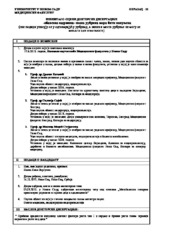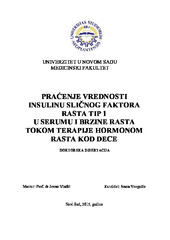Приказ основних података о дисертацији
Praćenje vrednosti insulinu sličnog faktora rasta tip 1 u serumu i brzine rasta tokom terapije hormonom rasta kod dece
Monitoring the levels of insulin-like growth factor type 1 in serum and the rate of growth velocity during growth hormone therapy in children
| dc.contributor.advisor | Vlaški, Jovan | |
| dc.contributor.other | Katanić, Dragan | |
| dc.contributor.other | Sajić, Silvija | |
| dc.contributor.other | Stojadinović, Aleksandra | |
| dc.contributor.other | Medić-Stojanoska, Milica | |
| dc.contributor.other | Velisavljev-Filipović, Gordana | |
| dc.creator | Vorgučin, Ivana | |
| dc.date.accessioned | 2020-07-03T13:27:28Z | |
| dc.date.available | 2020-07-03T13:27:28Z | |
| dc.date.issued | 2015-12-18 | |
| dc.identifier.uri | http://www.cris.uns.ac.rs/DownloadFileServlet/Disertacija144109544900939.pdf?controlNumber=(BISIS)95556&fileName=144109544900939.pdf&id=4233&source=NaRDuS&language=sr | sr |
| dc.identifier.uri | https://nardus.mpn.gov.rs/handle/123456789/4749 | |
| dc.identifier.uri | http://www.cris.uns.ac.rs/record.jsf?recordId=95556&source=NaRDuS&language=sr | sr |
| dc.identifier.uri | http://www.cris.uns.ac.rs/DownloadFileServlet/IzvestajKomisije144109544191936.pdf?controlNumber=(BISIS)95556&fileName=144109544191936.pdf&id=4232&source=NaRDuS&language=sr | sr |
| dc.description.abstract | Hormon rasta ima ključnu ulogu u mnogim fiziološkim procesima, anabolički efekti, stimulisanje rasta dugih kostiju, regulacija transkripcije gena u ciljnim ćelijama su uglavnom posredovani preko mitogenog polipeptida, insulinu sličan faktor rasta tip 1 (insulin like growth factor 1-IGF-1). Hormon rasta indukuje proizvodnju IGF-1 u jetri, koji reaguje sa receptorima ciljnih organa indukujući rast, odnosno IGF-1 posreduje svim stimulativnim dejstvima hormona rasta na kost, hrskavicu, rast mišić a i na metabolizam masti i ugljenih hidrata. U proceni redovnosti, bezbednosti i efikasnosti terapije hormonom rasta koristi se merenje koncentracije IGF-1 u serumu. Istraživanje je urađeno kao retrospektivno-prospektivna studija, a obuhvatilo je 80 pacijenata na terapiji hormonom rasta koja se kontrolišu i leče na Odeljenju za endokrinologiju, dijabetes i bolesti metabolizma Instituta za zdravstvenu zaštitu dece i omladine Vojvodine u Novom Sadu. Istraživani uzorak je obuhvatio 80 pacijenata, od kojih 35 dece sa nedostatkom hormona rasta, 24 dece rođene male za gestacionu dob i 21 devojčicu sa Tarnerovim sindromom. Svi ispitanici su praćeni od početka primene hormona rasta i tokom prve dve godine terapije hormonom rasta. U ovom istraživanju su praćeni auksološki i laboratorijski parametri u cilju ispitivanja odgovora na terapiju hormonom rasta. Praćene su bazalne vrednosti IGF-1 i promene nivoa IGF-1 u serumu tokom terapije hormonom rasta i korišćene da bi se ispitao odgovor na terapiju hormonom rasta, praćenjem brzine rasta, promena skora standardnih devijacija - SSD za telesnu visinu i koštanog sazrevanja. Ciljevi istraživanja su bili da se utvrdi povezanost vrednosti insulinu sličnog faktora rasta tip 1, brzine rasta i koštanog sazrevanja tokom terapije hormonom rasta. Takođe je poređena brzina rasta dece sa deficitom hormona rasta, devojčica sa T arnerovim sindromom i dece rođene male za gestaciono doba na terapiji hormonom rasta. U istraživanom uzorku, dvogodišnjim praćenjem terapije hormonom rasta je postignut dobar odgovor na terapiju, među decom sa nedostatkom hormona rasta je 71,5% postiglo normalnu telesnu visinu (±2 SSDTV) posle dve godine terapije hormonom rasta, 79,2% dece rođene male za gestacionu dob i 42,9% devojčica sa Tarnerovim sindromom. Značajna zastupljenost dece prepubertetskog uzrasta na početku terapije hormonom rasta, među decom sa nedostatkom hormona rasta 77,2%, među decom rođenom malom za gestacionu dob 79,1% i među devojčicama sa Tarnerovim sindromom 90,5% što je značajno uticalo na uspešnost terapije. Tokom terapije hormonom rasta je utvrđeno povećanje brzine rasta i SSD TV kod sve tri grupe ispitanika. U sve tri grupe ispitanika je tokom terapije hormonom rasta utvrđen porast nivoa IGF-1 seruma i SSDIGF-1 i ubrzanje koštanog sazrevanja tokom terapije hormonom rasta. Za prvih šest meseci terapije nema statistički značajnih razlika među grupama u brzini rasta (p>0,05), dok je za period prve i druge godine terapije hormonom rasta utvrđeno da postoji statistički značajna razlika među grupama (p<0,05), da je brzina rasta kod devojčica za Tarnerovim sindromom statistički značajno manja i od brzine rasta kod dece sa nedostatkom hormona rasta (p <0,05), i od brzine rasta kod dece rođene male za gestacionu dob (p<0,05). Među decom sa nedostatkom hormona rasta i dece rođene male za gestacionu dob nema statistički značajne razlike u brzini rasta (p>0,5). U ovom istraživanju je praćenjem auskoloških i laboratrijskih parametara tokom dvogodišnje primene hormona rasta, konstruisano više matematičkih modela za predviđanje odgovora na terapiju hormona rasta koji su statistički veoma značajani sa visokim koeficijentom višestruke linearne korelacije. U ovom istraživanju nije dobijena statistički značajna korelacija izmedju nivoa promene IGF-1 i brzine rasta za ceo uzorak, kao ni za decu sa nedostatkom hormona rasta, decu rođenu malu za gestacionu dob i devojčice za Tarnerovim sindromom. Nije dobijena statistički značajna korelacija izmedju nivoa promene IGF-1 i ubrzanja koštanog sazrevanja za ceo uzorak i za tri grupe pacijenata. | sr |
| dc.description.abstract | Growth hormone plays a key role in many physiological processes. The anabolic effects, the stimulation of growth of the long bones and the regulation of gene transcription in the target cells are mediated mainly via mitogenic polypeptide and insulin-like growth factor type 1 (insulin like growth factor 1-IGF-1). Growth hormone induces the production of IGF-1 in the liver, which interacts with receptors of the target organs inducing growth, that is, IGF-1 mediates all the stimulating effects of growth hormone on bone, cartilage, muscle growth and the metabolism of fats and carbohydrates. In assessing the regularity, safety and efficacy of growth hormone therapy, measuring the concentration of IGF-1 in serum is used. The survey was conducted as a retrospective-prospective study and involved 80 patients treated with growth hormone, monitored and treated at the Department of Endocrinology, Diabetes and Metabolic Diseases, at the Institute for Health Protection of Children and Youth of Vojvodina in Novi Sad. Investigated sample included 80 patients, of whom 35 children have growth hormone deficiency, 24 children were born small for gestational age and 21 girls with Turner syndrome. All the patients were monitored from the beginning of the administration of growth hormone and during the first two years of growth hormone therapy. In this study, auxological and laboratory parameters were monitored for the purpose of examining the response to treatment of growth hormone. The basal values of IGF-1 and changes in IGF-1 levels in serum, along with monitoring the rate of growth velocity and recent changes in standard deviation - SSD for body height and bone maturation, were monitored during growth hormone therapy and used for the evaluation of the response to growth hormone therapy. The objectives of the study were to determine the correlation of insulin-like growth factor type 1 values, the growth velocity and maturation of bone during growth hormone therapy. Also, the growth velocity in children with growth hormone deficiency was compared with the growth velocity in girls with Turner syndrome and in children born small for gestational age while treated with growth hormone. Two-year monitoring of growth hormone therapy in the study sample has show n good response to therapy. 71.5% of children with growth hormone deficiency, 79.2% of children born small for gestational age, and 42.9% of girls with Turner syndrome achieved normal body height (± 2 SSDTV) after two years of growth hormone therapy. There was a significant share of children at prepubertal age at the beginning of growth hormone therapy: 77.2% of children with growth hormone deficiency, 79.1% of children born small for gestational age and 90.5% of girls with Turner syndrome, which significantly influenced the success of the therapy. During the growth hormone therapy there was an increase of growth velocity and SSD TV in all three groups of children. An increase in levels of IGF-1 serum and SSDIGF-1 and acceleration of bone maturation were determined in all three groups of patients during growth hormone therapy. For the first six months of therapy there was no statistically significant difference between groups in growth velocity (p> 0.05), while the period of the first and second year of growth hormone therapy showed a statistically significant difference between groups (p <0.05). The growth velocity in girls with Turner syndrome was significantly lower than the growth velocity in children with growth hormone deficiency (p <0.05) and in children born small for gestational age (p <0.05). Between children with growth hormone deficiency and children born small for gestational age there was no statistically significant difference in growth velocity (p> 0.5). By monitoring auxological and laboratory parameters during the two years of application of growth hormone, several highly statistically significant mathematical models for predicting the response to treatment of growth hormone were constructed in this study with a high coefficient of multiple linear correlation. In this study, there was no statistically significant correlation between the level of change in IGF-1 and growth velocity for the entire sample, as well as for children with growth hormone deficiency, children born small for gestational age and girls for Turner syndrome. There was no statistically significant correlation between the level of change in IGF-1 and acceleration of bone maturation for the entire sample and for the three groups of patients. | en |
| dc.language | sr (latin script) | |
| dc.publisher | Универзитет у Новом Саду, Медицински факултет | sr |
| dc.rights | openAccess | en |
| dc.rights.uri | https://creativecommons.org/licenses/by-nc-nd/4.0/ | |
| dc.source | Универзитет у Новом Саду | sr |
| dc.subject | Insulinu sličan faktor rasta tip 1 | sr |
| dc.subject | Insulin-Like Growth Factor I | en |
| dc.subject | Small for Gestational Age | en |
| dc.subject | Growth Hormone | en |
| dc.subject | Growth | en |
| dc.subject | Turner Syndrome | en |
| dc.subject | Growth Disorders | en |
| dc.subject | Child | en |
| dc.subject | Bone Development | en |
| dc.subject | Infant | en |
| dc.subject | Hormon rasta | sr |
| dc.subject | Rast | sr |
| dc.subject | Tarnerov sindrom | sr |
| dc.subject | Poremećaji rasta | sr |
| dc.subject | Deca | sr |
| dc.subject | Razvoj kostiju | sr |
| dc.subject | Novorođenče rođeno malo za gestacionu dob | sr |
| dc.title | Praćenje vrednosti insulinu sličnog faktora rasta tip 1 u serumu i brzine rasta tokom terapije hormonom rasta kod dece | sr |
| dc.title | Monitoring the levels of insulin-like growth factor type 1 in serum and the rate of growth velocity during growth hormone therapy in children | en |
| dc.type | doctoralThesis | en |
| dc.rights.license | BY-NC-ND | |
| dcterms.abstract | Влашки Јован; Катанић Драган; Сајић Силвија; Стојадиновић Aлександра; Медић-Стојаноска Милица; Велисављев-Филиповић Гордана; Воргучин Ивана; Праћење вредности инсулину сличног фактора раста тип 1 у серуму и брзине раста током терапије хормоном раста код деце; Праћење вредности инсулину сличног фактора раста тип 1 у серуму и брзине раста током терапије хормоном раста код деце; | |
| dc.identifier.fulltext | https://nardus.mpn.gov.rs/bitstream/id/35121/Disertacija342.pdf | |
| dc.identifier.fulltext | https://nardus.mpn.gov.rs/bitstream/id/35120/IzvestajKomisije342.pdf | |
| dc.identifier.fulltext | http://nardus.mpn.gov.rs/bitstream/id/35120/IzvestajKomisije342.pdf | |
| dc.identifier.fulltext | http://nardus.mpn.gov.rs/bitstream/id/35121/Disertacija342.pdf | |
| dc.identifier.rcub | https://hdl.handle.net/21.15107/rcub_nardus_4749 |



